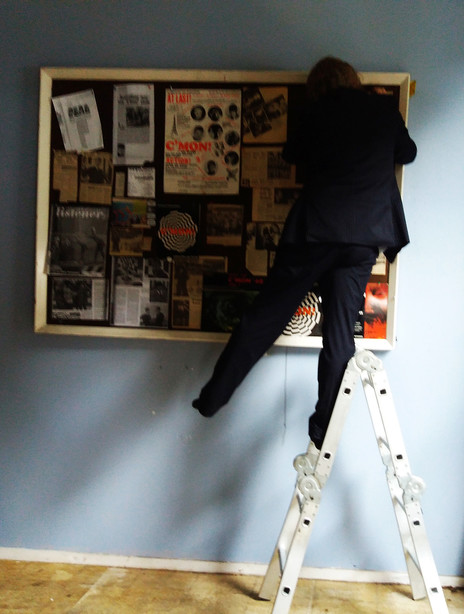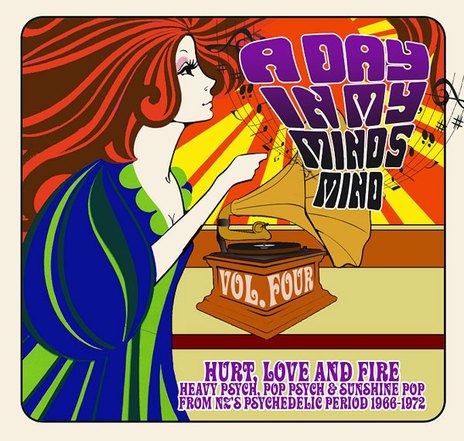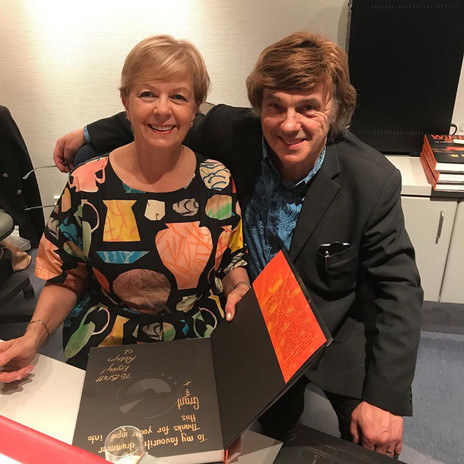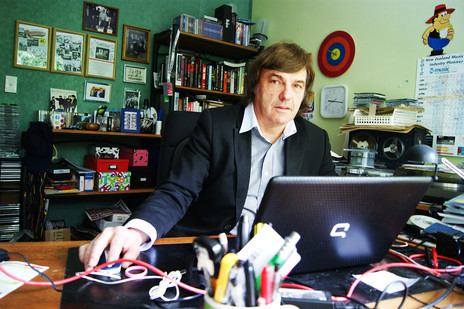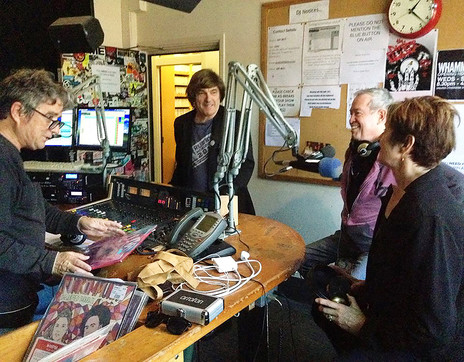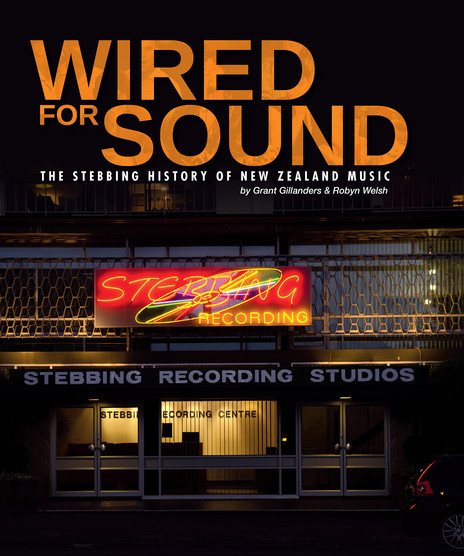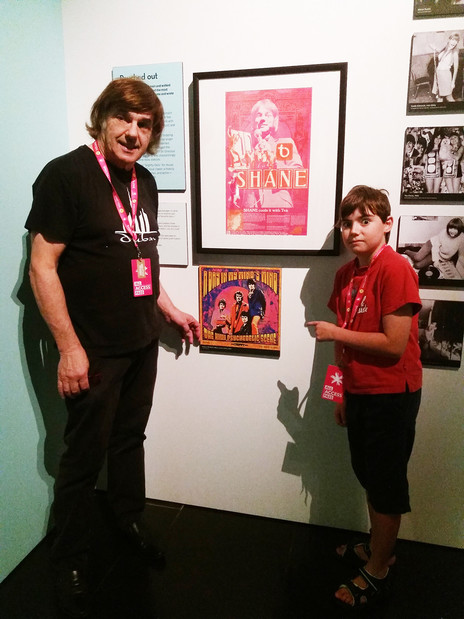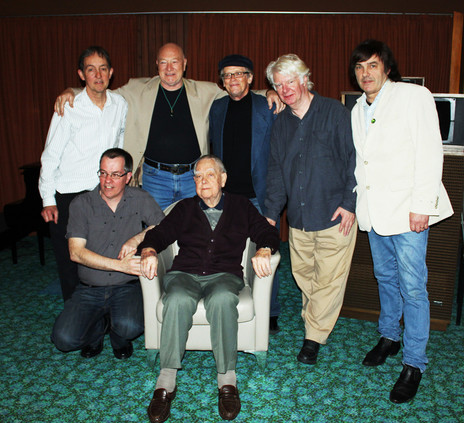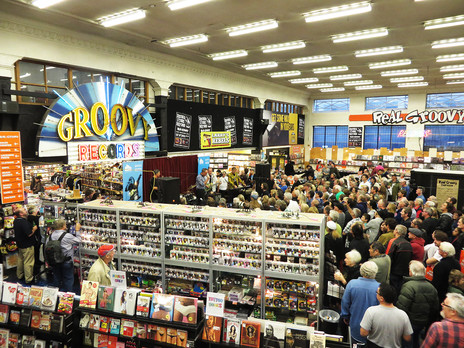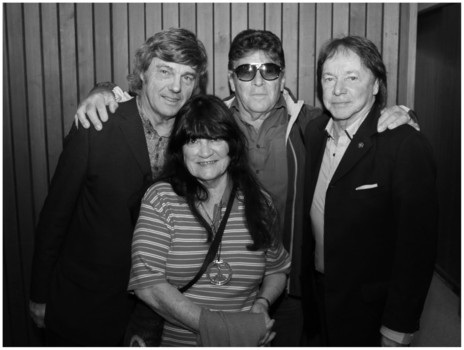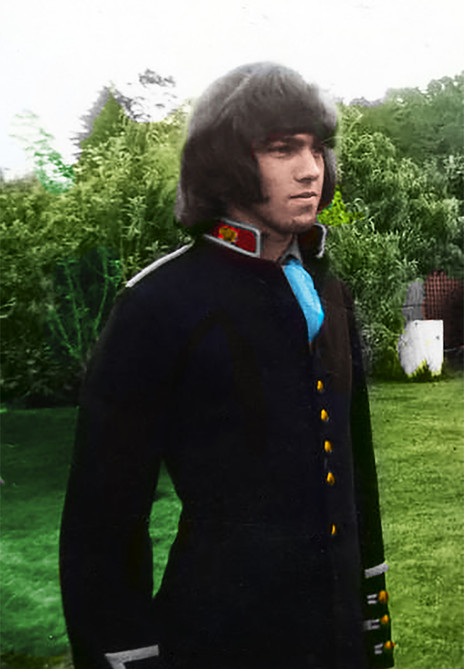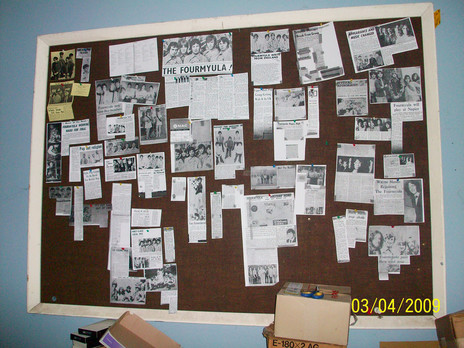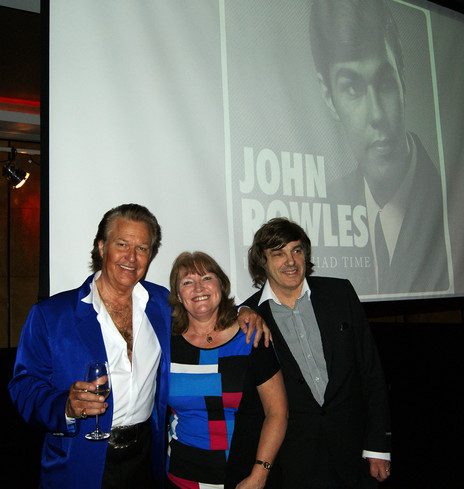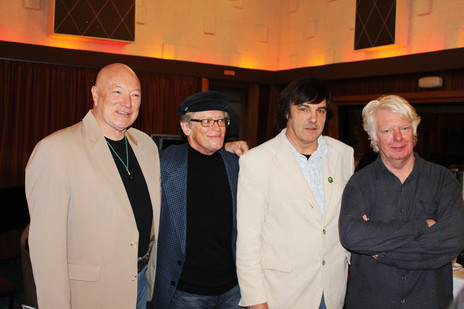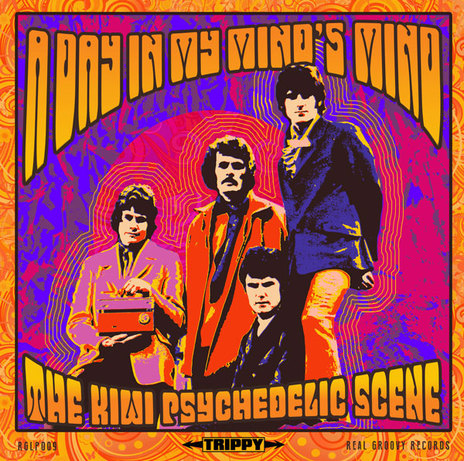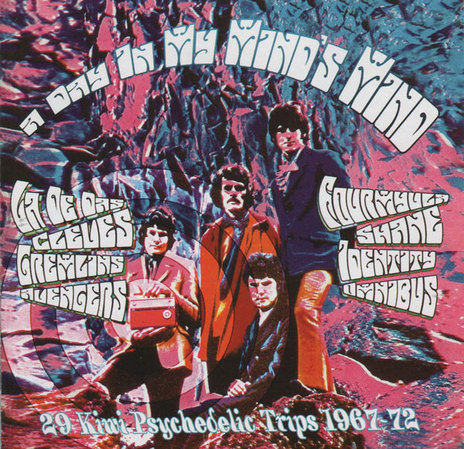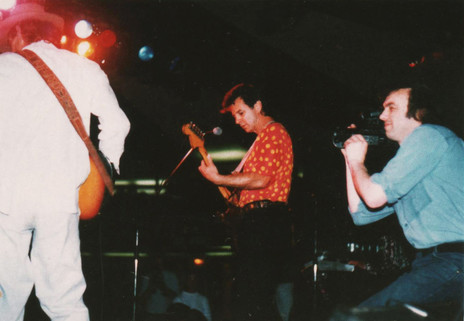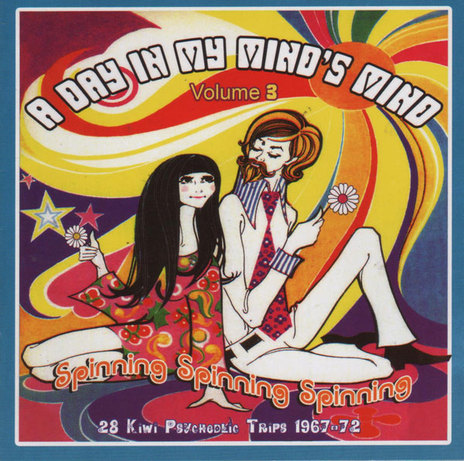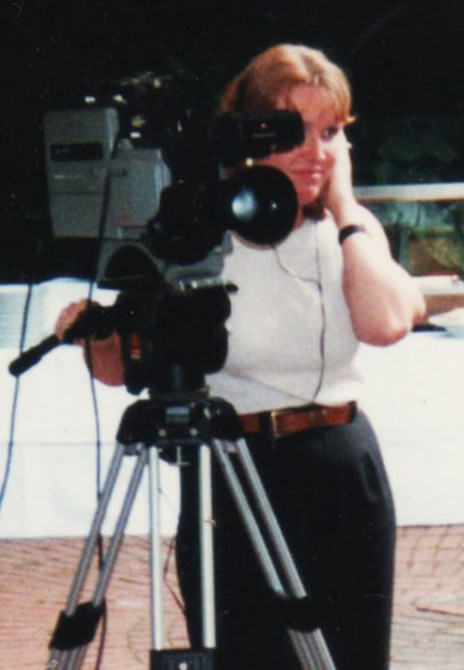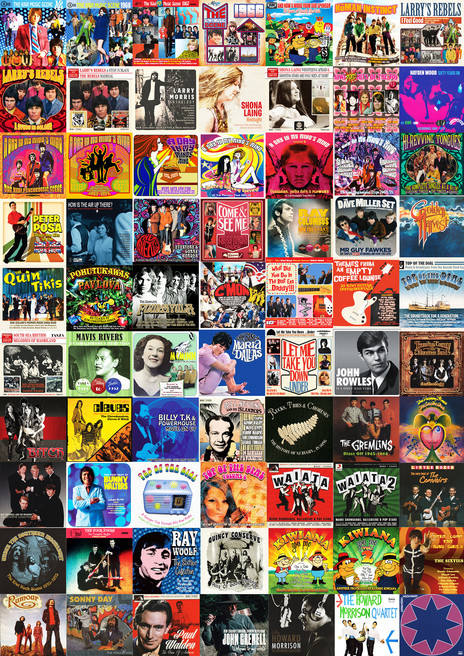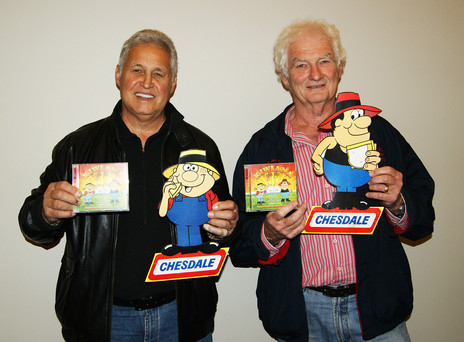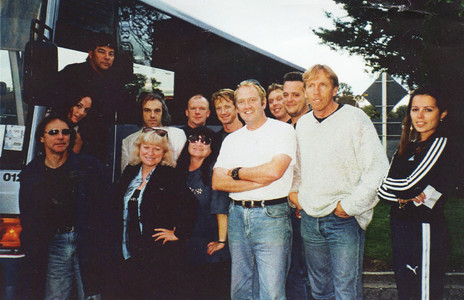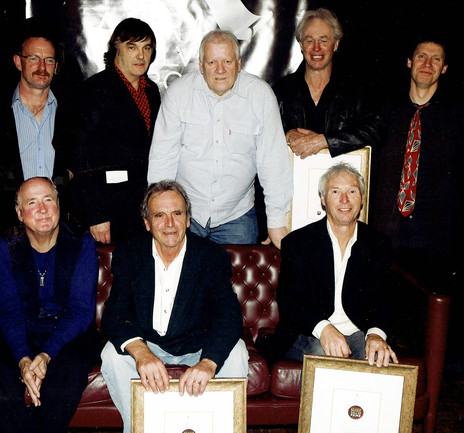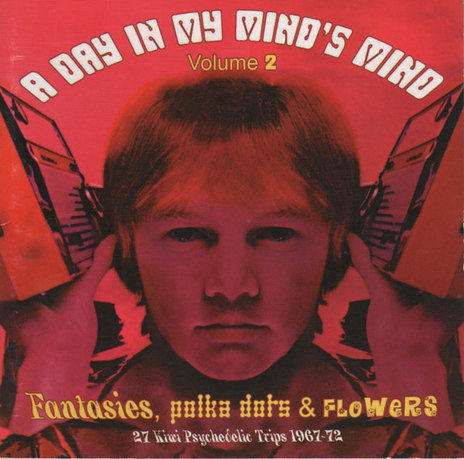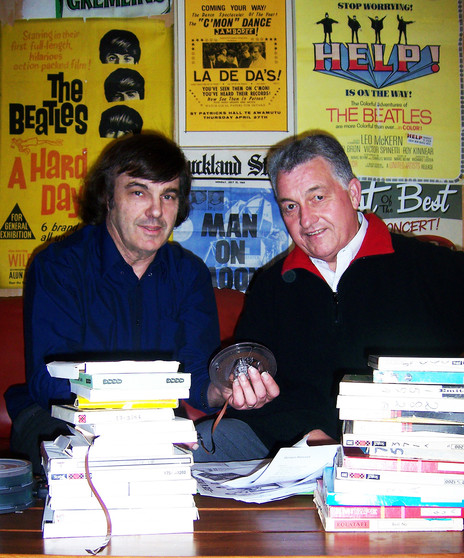Grant Gillanders was born in 1954 and initially raised in the west Auckland suburb of Te Atatu. Two houses from his family home lived the well-known baritone Mark Pedrotti, who recorded for the Kiwi and Zodiac labels. Further down the road was Brett Neilsen, who from 1963 was the teenage drummer with The Mergers, soon to be known as The La De Da’s.
At age five Grant’s grandfather gave him a portable record player and he acquired his first couple of records: the children’s story and Sunday morning radio show favourite ‘Little Toot’ and the Howard Morrison Quartet’s ubiquitous 1959 smash hit for Zodiac Records, ‘The Battle Of The Waikato’. Within a couple of years, he had quite a big collection of 45s. “People would give me records and Dad used to go around a couple of the hamburger shops up in Ponsonby and buy their ex-jukebox singles.”
When Grant was eight, the family moved into Sherwood Avenue in Westmere, which opened up a new world of pop culture for him. A right turn at the front gate took you to Saturday matinees at the Cameo Theatre, where Cliff Richard and Elvis Presley movies regularly screened. A left turn and up Francis Street led to the Richmond Road Theatre for a weekly fix of westerns and Charlie Chaplin double features. Even the power poles were adorned with posters for upcoming Town Hall concerts, which made essential reading. But just as importantly, it meant living closer to two slightly older female cousins who dragged Grant further into the pre- and post-Beatles music scene.
On the corner was a fish and chip shop owned by a friendly English woman. Young Grant was unaware that the woman was the mother of Trevor Wilson, another member of The La De Da’s – the future Australasian rock’n’roll stars practised out the back of the shop. It was Mrs Wilson who famously gave the band, who had renamed themselves from The Mergers to The Criminals, the name they used from 1965 onwards when she suggested, “Why don’t you call yourselves something nice like the la-de-das?”
When Grant was nine the The La De Da’s played their first major show at Western Springs in an extravaganza promoted by Ray Columbus. It was a few hundred metres from the Gillanders home and Grant was too young to go. It was, however, the talk of the neighbourhood.
At Westmere Primary School he showed little interest in actually playing music and was one of the few in his year not in the choir or the orchestra.
The family then moved to Whangaparoa, north of Auckland. Sparsely inhabited in those days, all the other kids Grant was friendly with at school lived literally miles away. For the next few years, he would come home and entertain himself by listening to the radio, especially the pop shows hosted by the likes of Peter Sinclair, and he began making lists of songs and writing down pop trivia. In the Hauraki Gulf off the coast of the Whangaparoa Peninsula, pirate radio station Radio Hauraki was broadcasting from the MV Tiri. The signal was so strong that it sometimes overpowered his school’s PA system.
“I wanted to buy music, with an emphasis on New Zealand and British music.”
Grant left school before completing his School Certificate, primarily so he could get a job and buy the records he so wanted to own. His school strengths were writing and art, talents he would find much use for in coming years.
His first jobs were as a retail assistant and then doing the door at Jan Grefstad’s Hollywood Cinema in Avondale. He used that income to buy records, catching up on all the music he had been unable to afford in his school years. “I just start buying all the records I’d heard in the last 10 years. I wanted to buy music, with an emphasis on New Zealand and British music.”
From there Grant trained and worked as a baker for eight years, becoming an in-demand French pastry chef. However, the advent of Saturday morning trading led to his resignation from the bakery. Grant was simply not keen on working weekends.
“I was always pretty good at photography. Then one day, I came home from work and started watching an Alfred Hitchcock movie and, because I was tired and half asleep, it just seemed to be more surreal. I was in another zone and thought it would be great to do some of those shots. I thought, ‘I reckon I could do that’. The following Monday, I went to the bank and got a $20,000 loan. This is about 1980.”
A large amount of money even now, it was a small fortune then, and Grant and Carol invested it in cameras and a visual mixing desk. They used it to create well-paying corporate videos which supported the creation of non-paying New Zealand pop videos – mostly live music videos of local bands playing on the weekends and at nights.
The first live music video Grant and Carol did was filming The Women in Blues at Auckland’s Gluepot in 1989, featuring Mahia Blackmore, Hattie St. James and Truda Chadwick. From there the pair, working with rock photographer Graham Hooper, started videoing bands and performers on most weekends, offering their services for free and giving the performers free copies of the videos they made. It was a labour of love funded by the lucrative commercial work they undertook. The emphasis was on artists with their histories rooted in the 1960s and 1970s, the era Grant was passionate about.
Their film work and the way they distributed copies to the bands led Grant and Carol to develop good relationships with performers, many of whom became part of their social circle.
Ray Columbus became increasingly important in their lives. “I actually met Ray Columbus through the conference work. We started working with Ray and I offered to videotape him performing. Over the next couple of years, he used to ring me every now and again and give me little video jobs. We got to know each other quite well.
“And then, in just a few days, three weeks before Christmas one year, I lost the part time job I was doing in a bakery while I built up the video business. The car literally blew up. A well-known Kiwi entertainer ordered a thousand bucks worth of stock from a shoot I’d done for him and did a runner with it – never saw him again – and I got burgled and lost all my video gear. Three weeks before Christmas and three kids, we hadn’t bought a Christmas present yet.”
A few days later, Ray rang to say hello and as always, ask how how he was doing. Grant let it all out. “I just had to tell him; this is what happened. He then said, ‘Can you paint?’ I said, no, not really. My father and my grandmother can paint. They were pretty good. They had lessons. But I’m pretty good at sketching and stuff. He said, ‘No, no, no … can you paint a house?’”
Within a couple of days, Grant was painting the Columbus home. Thanks to Ray’s support and generosity, he was able to pay the bills and the mortgage – and buy his kids presents for Christmas.
As the job progressed, Ray found Grant work with other friends of the family. The painting work stretched until Easter the following year when Ray and Grant decided to take their business relationship further.
“I was doing a couple of music documentaries at the time and I didn’t have the money to finish it. Ray gave me a hundred bucks to finish them and we then formed our own production company, just to do Kiwiana type stuff. We were called PAV Productions, a name that Ray came up with, taken from pavlova. It lasted for the next 20 years.”
The duo pitched Kiwiana themed ideas at both TVNZ and NZ On Air. The latter wasn’t interested but TVNZ expressed some interest in a late-night show. The timing however, meant funding was hard to find, so it was dropped. They were ahead of their time given the explosion in interest in celebrating New Zealand’s visual and audio history that would follow in the next few years.
Grant and Carole were offered work on tv3’s music show ‘Frenzy’, filming bands with two cameras.
The partnership also created a pilot for a show they wanted to call How Is The Air Down There, a chronological history of New Zealand music, with the pilot focusing on 1965-66, but once again they found little interest. Built around footage Grant filmed of a reformed La De Da’s performing at the Galaxie nightclub reunion show in 1990, they offered it to TV3. The station’s programmer said he personally liked it but, “no one’s interested in Kiwi music. It’ll never take off.”
Instead, Grant and Carole were offered work on TV3’s new music show Frenzy, filming bands with two cameras. Carole would be down the back of the room doing long shots and Grant would roam with another camera doing, as he calls it, “arty-farty” shots. That lasted one season, after which the show canned live performances and limited the in-studio filming to interviews.
Over this period, Grant and Carole continued to film bands in concert, providing a free service and giving the artists copies. The couple were ubiquitous in the Auckland live scene throughout the 1980s and 90s – they created a large archive of live and studio performances which are currently in storage, with loose plans to have it all digitised in the future – when Grant finds a moment.
Compilations
In 1999, Grant Gillanders moved into the creation of CDs. This is something he is perhaps best known for now with 89 – and counting – compilations and reissues to his credit. But it was almost accidental.
Grant had fallen for the CD format in the 1980s and over the years sold much of his vinyl collection and replaced it with CDs. But he was often disappointed with the standard of the packaging on the collections of the 60s and 70s music he so loved. That was, until he walked into Real Groovy in Auckland in 1998 and saw a CD on the UK RPM Records label: a reissue of former Manfred Mann singer Paul Jones’ solo work.
“I’m a big Paul Jones fan. I opened it up and was just blown away. What they were doing with the artwork was what I was doing with video mixing – putting underlays under the pictures, with colour and different angles. Everything before it was just so dull.”
A year later, the Gillanders decided to sell their house and when the agent said it needed new tiling in the bathroom, Grant approached singer Shane Hales, a friend who lived around the corner and owned a tiling business.
While Shane was laying the tiles, he told Grant he was somewhat miffed by EMI’s failure to release a collection of his 1960s work in their new mid-priced series of their artists from the era. He had, after all, been among their biggest local stars of the decade with a Loxene Golden Disc award to his name.
Grant said he had a contact at EMI, having supplied a photo (of The Simple Image) for one of their compilations and offered the number of Bob Anderson at EMI. Shane asked if Grant would call on his behalf. He did and Anderson explained that Shane’s master tapes were something of a mess and that was why he hadn’t issued the collection. Grant offered to bring the singer in to EMI to go through them. Anderson then suggested that Grant go one step further and compile the CD.
When Grant rang EMI to ask who was writing the liner notes, Bob Anderson said, “You are, buddy.”
Shane and Grant went through Shane’s scrapbook and photos and put together a layout along the lines of the RPM-issued Paul Jones CD, albeit restricted to black and white because of printing costs. When Grant rang EMI to ask who was writing the liner notes, Bob Anderson said, “You are, buddy”. So he did.
EMI were impressed enough by the delivered project to up the price-point from the $9.99 the earlier EMI compilations were listed at to $12.99, and then asked Grant if he had any more ideas for collections. He took them a list of 10 ideas, and they accepted them all. That began a relationship that would create 20 albums by the time EMI closed their New Zealand non-sales office in 2010, mostly taken from the EMI and HMV archives, but also licensed releases (eg a best of The Gremlins).
The fourth CD in that list was the landmark A Day In My Mind’s Mind, a collection of psychedelic New Zealand tracks from the 1960s that surprised everyone – aside from Grant Gillanders who instinctively knew it was a winner – and sold and sold. It launched a series that now stretches to five CD volumes and a vinyl edition.
A Day In My Mind’s Mind changed the way New Zealanders regarded the deeply melodic psychedelic pop created here in the mid- to late-1960s. When approached to clear his band’s 1968 hit for the first volume, one well-known musician said, “Surely there’s not enough Kiwi psychedelic tracks to fill a CD.”
It also pushed the second-hand prices of many of these singles through the roof. “We shot ourselves in the foot there,” Grant says with a grin.
The first volume included a couple of unreleased tracks – Volume 5, released in late 2018, was 80 percent unreleased. The relationship Grant has established with musicians from the era is unquestioned and unique, with many offering him pointers towards demos and live recordings.
Once a band member mentions unreleased recordings, Grant attempts to track them down. They can be hard or easy to find, depending on the record company. EMI, PolyGram, RCA and Pye outtakes are largely missing, thrown away over the years, whereas indie labels such as Viking, Kiwi and Zodiac kept much of what they recorded. It was the latter company – Eldred Stebbing’s ground-breaking Auckland indie label Zodiac – with whom a special relationship developed over the years.
Over the next couple of years, Bob Anderson and Grant would from time to time take a list to Chris Caddick, the EMI boss, until one day Caddick said, “Look guys, you come up, you come in here regularly with these ideas. Don’t bother, just go away and do it. Just don’t lose any money.”
In 2005, Grant decided to compile a Sandy Edmonds collection. The popular singer, once a household name, had recorded for Zodiac and then for her manager Phil Warren’s James Productions company, co-owned by producer and saxophonist Jimmie Sloggett. The Warren family gave Grant full access to all the recordings they owned. Neither they nor the earlier Zodiac recordings had ever been reissued, apart from her one big hit ‘Daylight Saving Time’ appearing on “best of the 60s” type collections. The singer herself was famously lost, having completely disappeared from public view around 1970.
“I was talking to Kevin McNeil from [60s band] The Mods, just by chance and mentioned I was wanting to do a CD of Sandy. He said that [former Dark Ages singer] Clive Coulson had spent some money with private investigators and managed to track her down. Kevin said Clive had found her [in Melbourne] just two weeks back and would I like her number? I said okay and I just gave her a ring. Sandy was fascinated by the idea. She gave me a list of stuff she didn’t want on there, and then she actually came over to New Zealand. She was so excited and spent a weekend with me working through it. It was the first CD where I was allowed to go full colour.
“Then Eldred Stebbing gave me a call – ‘Can you come and see me?’ I had interviewed him in the past for various video projects, so I headed over. As I waited outside his office, I overheard him on the phone and I thought, l’ll just stay here because I don’t want to walk in while he’s on the phone to someone. He was raving to this guy on the other end, saying things like ‘You should see it. It’s full of colour and it’s just so well done. I’ve never seen anything like it before. It’s just so informative. It looks good.’ I was just standing there thinking gee, someone is getting big raps.”
“I walked in and he had the Sandy Edmonds CD on his desk. That’s when it clicked … he looked up and just said, ‘You did a good job on this.’”
Despite the understated praise, Eldred offered the Zodiac catalogue to Grant and asked him to come up with concepts. While Eldred’s declining health slowed the process, the result was several collections and reissues, notably the 2009 Ray Columbus & The Invaders compilation and the more recent 2017 Golden Harvest reissue, taken directly from the studio’s original multi-track tapes.
2009 was a pivotal year for Grant. As a result of the connections made, he was commissioned to co-write the history of Zodiac Records and the Stebbing family’s work in the New Zealand music industry, working with Eldred’s daughter-in-law Robyn Welsh.
Grant started work on his biggest project to date with a four-CD collection, ‘The Complete Fourmyula’.
Also, his work with EMI was winding down simply because EMI itself was winding down in New Zealand. The company that once completely dominated the New Zealand music industry (before 1949, it was the New Zealand music industry) was being downgraded to essentially a sales and marketing branch of an Australasian company. Grant’s ally Chris Caddick was gone – he was dealing with the marketing manager Thierry Pannetier, with whom he had developed a close relationship – so close, they talked about forming a label. They planned to call it Frenzy, the FR standing for Pannetier’s homeland of France and the NZ being Grant.
In 2009, too, Grant started work on his biggest project to date with a four-CD collection, The Complete Fourmyula. Disc one was the Fourmyula’s complete singles A-sides and B-sides. Disc two was their debut album and the second album, Green B Holiday. Disc three had their Live and Creation albums while the fourth disc included the full, unreleased Decca-recorded UK album. Plans were undertaken for a separate, limited vinyl version of the unreleased album.
The unreleased album Turn Your Back On The Wind was originally produced by UK producer Chris Andrews and it had a mighty reputation among the lucky few who had heard it. Tracking down tapes proved to be harder.
“The band had had poor quality cassette copies of the unreleased album for quite some time,” says Grant. “[Collector] Colin Linwood suggested its release as part of the box set if the tapes could be found.
“Thierry [Pannetier] and Chris [Caddick] were enthusiastic. I contacted Universal in the UK, who confirmed their existence minus the original artwork. Thierry arranged for the licensing and transfers. I designed the cover as it appears in the booklet, based on the group’s recollection of the completed/missing artwork. Before it could be released, EMI was restructured and Thierry was made redundant as had Chris before [him]. The project was then shelved by the new CEO but I managed to talk him into a release about six to 10 months later, only because the bulk of its production had been paid for before being shelved.”
The resurrected Fourmyula project’s budget didn’t include the vinyl of the unreleased album. Wellington archivist Colin Linwood decided he would look after the production of the vinyl album and, with EMI’s blessing, took over that side of the project.
As was apparent when it was issued, the album was everything its reputation indicated and the limited-edition vinyl and CD box were issued in 2010.
As EMI’s work tapered off (the company was eventually purchased by Universal in 2012), Grant created his new Frenzy label (now without Thierry), funded in large part by a publishing advance he received for the Stebbing book, and in partnership with Ode Records, owned by Roger Marbeck, who also owns the legendary family record store.
The first release under the joint venture was Ray Woolf’s The Sixties Collection, created with the same care, attention to detail and impressive graphics that had become a hallmark of Grant’s work via EMI. Indeed, a look had developed, and a Grant Gillanders release was easily identifiable in the stores.
“People say they can pick my artwork. People also say they can tell I wrote the liner notes – ‘it sounds like you talking’ – and I have colourful spines on my CDs because that’s what people see much of the time. They are ignored by many companies but it’s important.”
The Ray Woolf collection brought together tracks from several labels, most unavailable since they appeared on 45s in the 1960s, and all remastered at Stebbing by Grant and engineer Simon Lynch. It included unreleased tracks, another Frenzy trademark.
“I’ve been talking to bands since the 1990s, and they quite often say, ‘we did some more tracks here or there’. You press them further and they’ll say, ‘oh they don’t really exist anymore’ or ‘I don’t know where they are’. However, you just keep going … you just keep looking for them and they often turn up.”
‘Kiwiana Goes Pop’ caught the imagination of the nation and sold like hotcakes.
The Ode relationship lasted for six releases until Grant decided he wanted to go it alone, pressing, wholesaling and marketing as well as creating the releases. In the interim he also put together compilations for Sony (a Howard Morrison solo-years set and a best of Tom Sharplin) and Universal. It was for the latter company that he produced Kiwiana Goes Pop, a diverse collection of Kiwi humour, pop, adverts, novelty tracks and simply identifiably New Zealand tunes.
With 78 tracks spread across two CDs, Kiwiana Goes Pop caught the imagination of the nation and sold like hotcakes, quickly reaching gold certification. It was only kept out of the top spot in the compilation charts by a couple of Christmas albums. For Grant (and his former videomaking partner Ray Columbus) it was vindication. He had been telling TV, radio and the likes of Air New Zealand over many years that this was a huge market, to mostly blank looks. He was right.
While all his CDs were selling well, “it was the age of radio advertising, the last days of radio advertising. You’d run a quick campaign on ZB nationwide and sell one or two thousand straight away. It doesn’t work anymore; radio advertising doesn’t work.”
Other titles followed: Larry’s Rebels, John Rowles, Shona Laing, Gray Bartlett, Mavis Rivers, New Zealand Beatles covers, 1960s garage bands, Bill Wolfgramm, instrumentals and many more, plus two more volumes of A Day In My Mind’s Mind. Each looked great and sounded as good as they looked, with loving attention paid to the mastering, always done at Stebbing Studios in Auckland’s Herne Bay.
All the while, Grant was co-writing the book that would become Wired For Sound: The Stebbing History Of New Zealand Music: “At the time, they paid me to write a 75,000 word book. I ended up giving them a hundred and eighty thousand words.”
Thanks in large part to Grant Gillanders’ dedication, New Zealand’s musical past has a mUCH higher profile.
Thanks in large part to Grant Gillanders’ dedication, New Zealand’s musical past, especially the 1960s and 1970s, probably had a higher profile in the mainstream than in its heyday.
Grant, in partnership with Auckland retailer Real Groovy, released another vinyl edition, this time a double album “best of” the A Day In My Mind’s Mind series. The store’s 33 1/3 birthday party on 22 November 2014 was filled to capacity , with a live band featuring Bill Ward (The Human Instinct), Ray Woolf, Johnny Ellis (Spectres), Glyn Tucker (The Gremlins) and Greg O’Donnell (The Music Convention). Customers queued to buy the album, the first 100 copies of which included an autographed sheet from band members, many of whom were partying in a private room backstage. The record was released in a thick board sleeve with liner notes and profiles from Grant.
More Frenzy/Real Groovy vinyl followed in 2015 when a double album of Clevedon pop band The Cleves and their later, harder rock alter-ego Bitch was released for Record Store Day 2015. Most of the Bitch recordings were previously unreleased. The same day a single disc compilation of the best of Larry’s Rebels, A Study in Colour, was also released.
In 2011, a Facebook page, NZ Music Scene, 1960s-1980s, was created by Linda Greer, wife of The Human Instinct’s Maurice Greer. Sadly, shortly afterwards Linda passed away – Grant was one of several who took over the page. To most members, it’s now a page they associate with Grant and his projects. At the time of writing it has almost 7000 members including dozens of the original musicians and it provides a fast and easy way to spread the news about Frenzy releases. It’s not unusual to find Chris Parfitt from The Hi-Revving Tongues chatting with Shane Hales or Larry Morris and fans from all generations. It’s also a place where fans and collectors share rare images, programmes, posters and music.
RPM
RPM Records, part of the large Cherry Red Records family in the UK with a global market and distribution, played a key role in the Frenzy story when Grant had seen the possibilities with that Paul Jones CD back in the 1990s.
In the years since, he’d sent copies of his work to the owner, Mark Stafford. Stafford was impressed and it started a conversation. They discussed marketing and compilation concepts. Grant was asked to help on an Alastair Riddell release RPM was doing and the relationship evolved from there. “He was always quite generous in his praise and he hinted a few times that we should do some stuff together. Nothing happened for about six years or so, then he wanted to do a Fourmyula collection and I worked on that.”
A superb single CD Fourmyula collection called Inside the Hutt: New Zealand’s Pop-Psych Kingpins 1968-1969 was released globally by RPM in 2013. “I supplied everything and wrote some notes and then they said we should do some more stuff. We’ve done about seven now: Larry’s Rebels, The Avengers, Come & See Me [NZ 1960s women artists], Ray Columbus, The Four Fours and Human Instinct, and the box set.”
The box set is the 2018 three-CD collection How Is The Air Up There? (80 Mod, Soul, RnB & Freakbeat Nuggets from Down Under), easily the most ambitious 1960s New Zealand compilation issued internationally ever. The reviews were uniformly strong:
The unifying factor here is how hard these bands play it. Their guitar fuzz stings a little harder, the rave-ups get a little louder and the vocal screams are a bit more unhinged than the kind you’ll find on the average comp of mid-60s British unknowns. – Midnight To Six
Versions of The Creation’s ‘Painterman’ and John Mayall’s ‘I’m Your Witchdoctor’ by Larry’s Rebels and Chants R&B respectively are ragged and exuberant and also capture the spirit of the times. As do The Selected Few and Bari And The Breakaways. The first named stamp their authority on The Pretty Things’ ‘Get The Picture’, the second on The Who’s ‘I Can’t Explain’. It’s explosive stuff. – Record Collector
I’m not going to mince words – this is pretty much excellence from beginning to end. – Louder Than War
The commitment to detail in the package was shown by the graphics found in the 36-page booklet. Next to the informative notes and images are each band’s unique logo: “As far as I know it’s the only CD that’s ever come out with a booklet where each group has got their name on it using the original logo. We haven’t just put such and such and then the track name. We’ve used the original fonts and designs.”
The Stebbing book ‘Wired For Sound’ was published in 2019 with a function at the famed studios.
The box was obviously targeting a younger generation too, and RPM were clear they wanted to sell to the European mod scene, rejecting some tracks suggested by Grant and asking for others. Even the NME liked it.
The Stebbing book Wired For Sound was published in November 2019 with a function at the famed studios. The Stebbing family were present as were many of the musicians whose musical careers been lovingly detailed and documented by Grant, the unassuming former pastry chef who has dedicated his life to the music he loves for four decades.
The reviews were strong and the book, available in bookstores and record shops, is well on its way to becoming a treasured New Zealand music reference work in years to come.
Meanwhile, the Corporate Cab that Grant once drove to support this passion sits idle and for sale outside his house. His only full-time “job” is telling the story of the music of our nation.
Has any band, label or musician ever said no to Grant? “Just one,” he winks, “but we don’t need to go there.”
